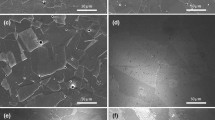Abstract
Materials for critical components in nuclear fuel reprocessing plants are required to have low corrosion rates and long designed life because access for repairs is not possible. Stainless steel type 304L, nitric acid grade (NAG), is the new material suitable for such applications. It has guaranteed low corrosion rates and is not susceptible to intergranular corrosion (IGC) in nitric acid environments. The corrosion behavior of type 304L stainless steel, NAG, and type 304L stainless steel, commercial purity (CP), in nitric acid environments is investigated in detail. Studied are: microstructural mapping in the three directions (longitudinal, long transverse, and short transverse), effect of sensitization heat treatment, resolution annealing and sensitization heat treatment for the as-received and cold-worked samples of the two varieties on the resultant microstructures. The anodic polarization characteristics along the three directions for both varieties in 1N HNO3 are compared. The susceptibility of both varieties to end grain corrosion in 9N HNO3 + 1 g Cr+6/liter boiling solution is assessed, and microstructural examination of the exposed sample is carried out to compare the degree of end grain corrosion. Their susceptibility to IGC due to segregation of impurity elements to grain boundaries is also compared. It is shown that controlled microstructure (fine grain size, retained cold work, and discrete precipitation at grain boundaries) along with controlled chemical composition is responsible for improved corrosion resistance of the NAG variety. The NAG variety has much less susceptibility to corrosion along the long- and short-transverse directions and, therefore, less susceptibility to end grain corrosion. The means and consequences of controlling chemical composition are also discussed.
Similar content being viewed by others
References
S.W. Dean, Corrosion Engineering in the Chemical Process Industries—A Story of Significant Success,Mater. Perform., Vol 30 (No. 6), 1991, p 63–71
C.P. Dhillon, Corrosion of Stainless Steels by Nitric Acid,Mater. Perform., Vol 31 (No. 7), 1992, p 51–53
R.D. Crooks, Corrosion by Nitric Acid,Metals Handbook, Vol 13, ASM International, 1987, p 1154–1156
V. Cihal, Low Carbon Steels Intended for Service in Nitric Acid,Intergranular Corrosion of Steels and Alloys, Materials Science Monographs No. 18, Elsevier, 1984, p 196–199
M.A. Streitcher, Theory and Applications of Evaluation Tests for Detecting Susceptibility to lntergranular Attack in Stainless Steels and Related Alloys: Problems and Opportunities in Intergranular Corrosion of Stainless Alloys,ASTM STP 656, American Society for Testing and Materials, 1978, p 3–84
R.L. Cowan and C.S. Tedman, Intergranular Corrosion of Iron-Nickel Chromium Alloys,Advances in Corrosion Science and Technology, Vol 13, M.G. Fontana and R.W. Staehle, Ed., Plenum Press, 1973, p 293–400
Handling Nitric Acid,Controlling Corrosion in Process Equipments, Kenneth J. McNaughton, Ed. McGraw Hill Publications Co., 1980, p 20–23
R.D. Shaw, Corrosion Prevention and Control at Sellafield Nuclear Fuel Reprocessing Plant,Br. Corr. J., Vol 25 (No. 2), 1990, p 97–107
M. Onoyama, M. Nakata, Y. Hirose, and Y. Nakagawa, Development of a High Performance Type 304L Stainless Steel for Nuclear Fuel Reprocessing Facilities,Third International Conference on Nuclear Fuel Reprocessing and Waste Management, RECOD-91, April 14–18, Sendai, Japan, Japan Atomic Industrial Forum, Tokyo, 1991, p 1066–1071
R.R. Kirchheiner, U. Heubner, and F. Hofman, Increasing the Lifetime of Nitric Acid Equipment Using Improved Stainless Steels and a Nickel Alloy,Mater. Perform., Vol 28 (No. 9), 1989, p 58–62
T.C. Spence, Cost Effective Material Selection: Cast Vs Wrought,Mater. Perform., Vol 31 (No. 7), 1992, p 59–60
J.C. Kelly, Today’s Vs Yesterday’s Stainless Steels,Mater. Perform., Vol 31 (No. 3), 1992, p 94–95
U. Kamachi Mudali, R.K. Dayal, and J.B. Gnanamoorthy, Advanced Materials of Construction for Spent Nuclear Fuel Reprocessing Plant Equipment,Bull. Electrochemistry, Vol 6 (No. 4), 1990, p 401–404
A262, Recommended Practices for Detecting Susceptibility to Intergranular Attack in Stainless Steels,ASTM Annual Book of Standards, Vol 01.03, American Society for Testing and Materials, 1989, p 1–18
M.J. Brown, Behaviour of Austenitic Stainless Steels in Evaluation Tests for the Detection of Susceptibility to Intergranular Corrosion,Corrosion, Vol 30 (No. 1), 1974, p 1–12
T. Gladman, A Nitric Acid Grade (NAG) SS 304L Austenitic Stainless Steel,Mater. Perform., Vol 28 (No. 2), 1989, p 60–61
V. Kain, S.S. Chouthai, and H.S. Gadiyar, Performance of AISI 304L Stainless Steel with Exposed End Grains in Intergranular Corrosion Tests,Br. Corr. J., Vol 27 (No. 1), 1992, p 59–65
J.S. Armijo, Intergranular Corrosion of Non Sensitized Austenitic Stainless Steels,Corrosion, Vol 24 (No. 1), 1968, p 24–30
S.M. Brummer, Grain Boundary Chemistry and Intergranular Failure of Austenitic Stainless Steels,Mater. Sci. Forum, Vol 46, 1989, p 309–334
El 12, Methods for Determining the Average Grain Size,ASTM Annual Book of Standards, Vol 03.01, 1989, p 284
Author information
Authors and Affiliations
Rights and permissions
About this article
Cite this article
Kain, V., Shinde, S.S. & Gadiyar, H.S. Mechanism of improved corrosion resistance of type 304l stainless steel, nitric acid grade, in nitric acid environments. J. of Materi Eng and Perform 3, 699–705 (1994). https://doi.org/10.1007/BF02818368
Published:
Issue Date:
DOI: https://doi.org/10.1007/BF02818368




